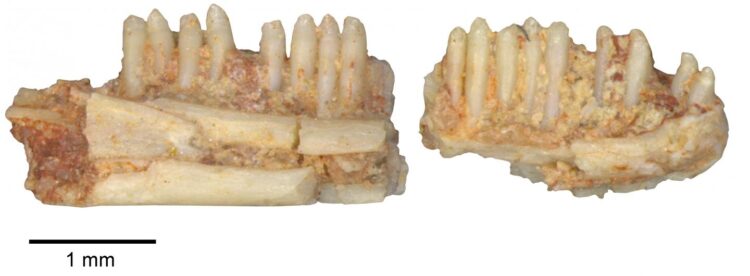The animal was approximately 10 cm long and lived more than 130 million years ago in what is now the state of Minas Gerais. Its morphology differs from that of all other known lizard species.

Credit: Jonathas Bittencourt
Fossil remains of a novel species of lizard that lived more than 130 million years ago have been found in the north of Minas Gerais, Brazil. It has been named Neokotus sanfranciscanus and is the oldest representative of the order Squamata ever found in South America.
Squamates are the largest reptile group, comprising lizards, snakes and amphisbaenians (worm lizards).
The discovery shows that scaled lizards were present on the continent at least 20 million years earlier than previously recorded and suggests that early South American squamates were part of a much broader global distribution, in contrast with the high levels of endemism (confinement to certain geographic regions) characteristic of modern species.
The fossil is described in an article published in Communications Biology.
The study was led by Jonathas Bittencourt, who was formerly awarded a postdoctoral research scholarship by FAPESP and is currently a professor at the Federal University of Minas Gerais (UFMG). The last author of the article is Max Langer, a professor in the Biology Department of the University of São Paulo’s Ribeirão Preto School of Philosophy, Science and Letters (FFCLRP-USP). The study was supported by the Minas Gerais Research Foundation (FAPEMIG) via a grant awarded to Bittencourt and by FAPESP via a Thematic Project led by Langer.
“This was a small lizard, approximately 10 cm long,” Langer told Agência FAPESP. “Its discovery in Brazil shows that the squamates were distributed throughout the world and were alive much earlier than we thought. This was only possible because, although the supercontinent Pangaea no longer existed, the continental lands were still relatively close to each other, allowing animals to disperse widely.”
The genus name Neokotus comes from Greek and means “novel and unfamiliar”. It was chosen because this animal’s morphology differs in several ways from that of all other species of Squamata. The specific epithet sanfranciscanus refers to the fact that the lizard’s fossilized remains were found in the Quiricó Formation, which is in the São Francisco River Basin.
“One of the morphological peculiarities of Neokotus is the shape of its ungual phalanges, which are terminal finger or toe bones. These bones end in nails in humans and in claws in other animals. In Neokotus, the base of the ungual phalanx was flat, a trait not found in any other known lizard. More detailed study of this feature is required, but it probably had something to do with locomotion,” Bittencourt said.
“Another peculiarity is the shape of its teeth, which had robust bases, tapering and curving inwards at the tip. We also have a theory about this: the shape of its teeth helped capture the insects it fed on.”
Bittencourt discovered Neokotus by chance. He was collecting scales from small sharks on a riverbank when he came across a block of sediment containing phalanges, vertebrae, teeth and other bones that did not appear to belong to fish. On assembling the bones and analyzing their mutual relationships, he realized they belonged to a lizard.
“I found approximately 30% of the fossil remains of a single individual,” he said. “The Quiricó Formation in the municipality of João Pinheiro in northern Minas Gerais must have included a large lake or several interconnected lakes in the remote past, as it’s very rich in fossils of lacustrine origin. I’ve been digging in the area since 2012. My field work consists of collecting chunks of rock, which I take back to the lab to be washed and broken up using hydrogen peroxide. I collect the tiny bones with brushes and tweezers.”
The rocks in which Neokotus was found were dated by means of microcrustaceans also embedded in the sediment.
“Many dinosaurs have been discovered in South America, but findings of small reptiles are also very important for the reconstruction of the scene at the time,” Langer said.
The article, “Discovery of the oldest South American fossil lizard illustrates the cosmopolitanism of early South American squamates”, can be read at: www.nature.com/articles/s42003-020-0926-0.
Media Contact
Heloisa Reinert
[email protected]
Original Source
http://agencia.
Related Journal Article
http://dx.





